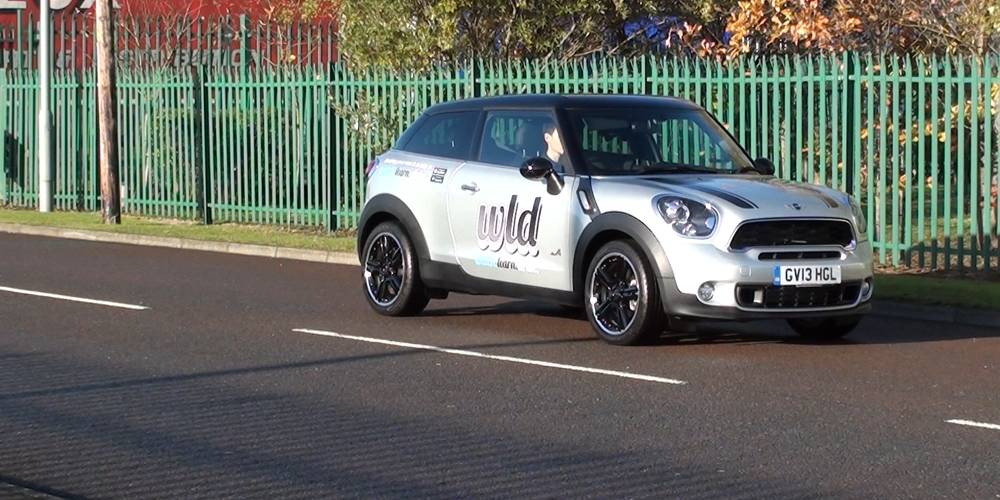
The guys in the picture are at 'dummy school'.
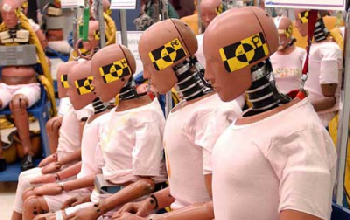 At dummy school, they learn stuff like:
At dummy school, they learn stuff like:
How to get distracted while driving
How to text and drive
How to use the phone when driving
How to break speed limits
How to ignore warning signs
How to race with their mates
And lots, lots more besides.
Most people never went to dummy school, but many seem to drive as if they had studied there for some unknown reason.
Not only do they drive that way, they often end up in the same situations as the guys from dummy school - crashing. As a result, they have high insurance costs, poor health resulting from broken bones, brain injuries or other trauma. Some aren't that lucky.
Highway Code information associated with this lesson can be found by clicking here - Rules 117 to 126. The rules (except rule 123) cover factors relevant to braking, emergency stops, and avoiding the need for emergency stops.
 Here's a question for you:
Here's a question for you:
"Do you want to take chances every day and risk the same fate as the dummies? Or do you want to stay safe, to stay alive?"
The first rule for emergency stops is that you should avoid the need.
With the advice given in this course and a safe and sensible attitude to other road users, you should rarely if ever, find yourself having to make an emergency stop.
BUT...
Unlike the dummies who are programmed to behave the way they do, we are all human, and, being human, we make mistakes.
The dummies never make mistakes – it's their job to crash. Your job is to stay on the road and get out of the car safely after your journey.
AND...
No matter how well you follow our advice, you might have a lapse of attention or judgement or meet another road user who has been to dummy school and suddenly does something you don't anticipate. In this situation, you will need to be able to stop quickly and safely.
The emergency stop (sometimes referred to as a 'controlled stop') is requested in one out of every three tests.
This exercise is not done on every test because the Driving Standards Agency believes it's more beneficial to have the extra 'driving time' during most tests.
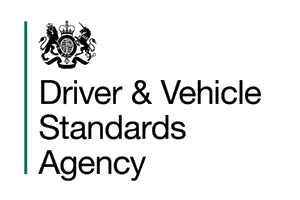
The decision about who gets an emergency stop is random, but following the advice in this lesson, the emergency stop will be easy to complete if it comes up on your test.
In this exercise, the driving test examiner will consider:
How promptly you stop
Whether you keep the car under control without locking the wheels
The distance taken to stop
Whether your stop was safe
The examiner will first ask you to pull up at a convenient place on the left and then explain the procedure to you and the signal they will give. Click the play button below to listen to the driving test examiner's instructions for this exercise.
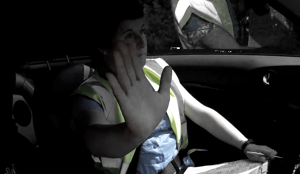 The examiner, like your instructor, will only use the command 'Stop!' for this exercise or in a real emergency - this is to minimise the risk of you accidentally misunderstanding and stopping suddenly in non-emergency situations.
The examiner, like your instructor, will only use the command 'Stop!' for this exercise or in a real emergency - this is to minimise the risk of you accidentally misunderstanding and stopping suddenly in non-emergency situations.
The examiner's signal will be a movement of their right arm with an outstretched hand.
Stop as quickly as you can when the signal is given.
You will not be expected to check your mirrors before stopping - examiners always look back to make sure it is safe before giving the signal - but you must remember all your safety checks before moving off.
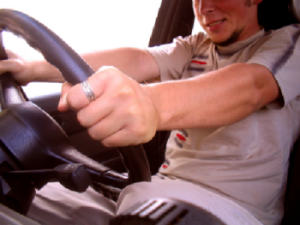
Although the emergency stop isn't included in every test, you still need to know how to do it - Just in case!
When we say 'just in case', we don't mean that you need it for the driving test - we mean just in case you need it to save your life or someone else's.
We have already said that you should never need to do an emergency stop when driving, and we hope you never will. But remember that being human and driving on the roads with other humans, the chances are that you will need your emergency stop skills one day.
Whether in a real emergency or just doing the driving test exercise, you must react quickly - every moment counts! Your mirrors become a low priority because you might not have time to make your normal safety checks; stop first, look later.
 Keeping your hands on the steering wheel is essential because the car's weight is thrown forward onto the front wheels during harsh braking, making it harder to steer. As the weight gets thrown forwards, the rear of the car becomes lighter, which means that the rear tyres are more likely to lose their grip (causing the car to skid). Maximum steering control is needed.
Keeping your hands on the steering wheel is essential because the car's weight is thrown forward onto the front wheels during harsh braking, making it harder to steer. As the weight gets thrown forwards, the rear of the car becomes lighter, which means that the rear tyres are more likely to lose their grip (causing the car to skid). Maximum steering control is needed.
Another benefit of keeping your hands on the wheel is that it will help to stabilise you in your seat: more stability, more control.
Above, we said that you should brake quickly, firmly and progressively, avoid 'stabbing wildly' at the brake pedal - this could cause the car to skid sideways.
Emergency stop control is easy if you follow the advice in this lesson.
The steering information is relevant for all vehicle types, but there are some differences in emergency stops in cars with manual transmission, automatics/hybrids and electric vehicles. These differences are covered under the relevant side-menu headings.
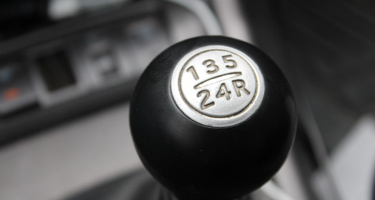
Press the footbrake before the clutch
Keep a firm grip on the steering wheel with both hands until the car has stopped
Pressing the brake before the clutch helps you to keep control. One theory for pressing the footbrake first is that 'engine-braking' helps to slow the car down. However, this effect is negligible (unless you are stopping on an extremely slippery surface like oil or ice).
A more important reason in the early stages of learning is that you must get the brakes 'biting' before the clutch is pressed.
Pressing the clutch down a fraction of a second before the brake can cause a brief surge forward, possibly making an inexperienced driver hesitate for a fraction of a second. In an emergency, every moment counts - at 50 miles per hour you will cover well over two metres in just one-tenth of a second!
You can time your use of the pedals by thinking or saying the words 'brake-and-clutch' to yourself at a normal speaking pace. Doing this will also help you stay calm because it will occupy your mind with helpful information. You will get the best results when you shout the words 'brake and clutch' out loud - but you might end up laughing or getting strange looks from pedestrians (especially if the car windows are open!).
As you think the word 'brake', press the brake quickly, firmly and progressively; the word 'and' provides a pause before pressing the clutch straight down to the floor.
In automatic and hybrid cars, press the brake quickly, firmly and progressively with your right foot to bring the vehicle to a stop.
Keep your left foot firmly on the floor - most automatics/hybrids will have a footrest for your left foot. Keeping your foot on the footrest will help stabilise your body in the seat; this will help you keep control.
In electric cars, regenerative braking reduces the need for the footbrake in everyday driving. Some models have a 'one pedal driving' feature which allows you to increase the amount that the car slows down when you ease off the power. But...
Regenerative braking is not enough for an emergency. Take the same action as in an automatic car and press the footbrake pedal firmly.
If you have previously practised the emergency stop in a manual or automatic car, there is a possibility that an electric car might take a little longer to stop than you expect. Electric vehicles are usually heavier than their equivalent petrol/diesel variant - the additional weight comes from the heavy batteries. The design of tyres for electric cars can also affect stopping distances.
Taking a little longer to stop is not a problem when you are learning and practising the emergency stop but can be a significant issue in a real emergency - always know your car and drive within its limitations.
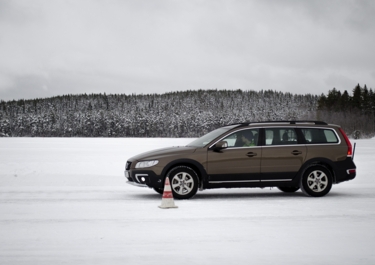 All modern cars have anti-lock brakes (ABS) and stability control systems.
All modern cars have anti-lock brakes (ABS) and stability control systems.
Anti-lock brakes prevent the wheels from locking under hard braking - stability control is a computerised system that helps the driver maintain control if one or more wheels lose grip on the road.
If you are driving a manual car, see your car handbook for advice about the best way to (emergency) stop your car with ABS. Manufacturers often recommend pressing the brake and clutch together.
When braking very hard or on slippery surfaces, you might feel a vibration in the brake pedal or hear a noise like the 'rat-a-tat' of a machine gun when the ABS activates. This is perfectly normal, caused by the system rapidly applying and releasing brakes.
Important: Anti-lock brakes and other stability features fitted to cars will help you maintain control and steer in an emergency, but they won't stop you quicker or prevent the car from skidding sideways in extreme situations. In other words, they are not a substitute for good driving (don't be a dummy!).
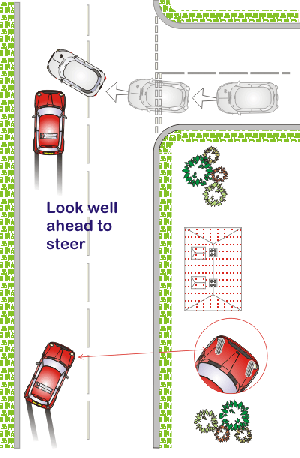 There are three things involved in all skids:
There are three things involved in all skids:
The driver
The vehicle
The road
But of these three things, it's only the driver who causes the skid.
Drivers can cause skids by harsh braking or acceleration, rough steering, excessive speed for the conditions, or (in a manual car) sudden release of the clutch pedal.
While skids are more likely in poor weather conditions, you must remember that you are responsible for adjusting your driving to suit the road and weather conditions to avoid skids.
Remember that while anti-lock brakes help maintain steering control, the car can still skid sideways in extreme circumstances.
If the car skids to the left or right (because it has become unbalanced), keep your foot on the brake, look well ahead and steer for safety.
By looking where you want to go, you will naturally turn the wheel in the direction of the skid; this will straighten the car and help you regain control; this is described as 'steering into the skid'.
Note: In old cars without anti-lock brakes, emergency stop skids happen when the driver brakes too hard. If you start to skid in a car without ABS, quickly release and reapply the footbrake. By doing this, you will maintain some tyre grip at the front wheels and possibly be able to avoid any danger or obstruction ahead.

By reacting quickly and braking firmly, you will have avoided the child who ran out from behind the ice-cream van, or the load that fell off the back of the lorry in front, or the cyclist who swerved out. But you are still in a potentially dangerous situation.
Although your mirrors will be a low priority in an emergency, you should check them as soon as you have hit the brake pedal or immediately after you have stopped. You might have to deal with problems from behind.
In a real emergency, this could mean quickly moving the car out of the way, for example, onto the hard shoulder of a motorway if fast traffic is bearing down on you from behind. Alternatively, you might need to make a rapid exit from your car to get to a place of safety.
In real emergencies, do whatever is necessary to stay safe. During lessons or the driving test, you will do one of the following:
apply the handbrake and select neutral in a manual or automatic car and wait for instruction from your instructor or the examiner.
apply the handbrake in an electric car and wait for instruction from your instructor or examiner.
or (any car) move to a safe parking position if you have agreed in advance with your instructor.
At this point, a few deep breaths are helpful to combat the effects of adrenalin in your blood and settle you down!
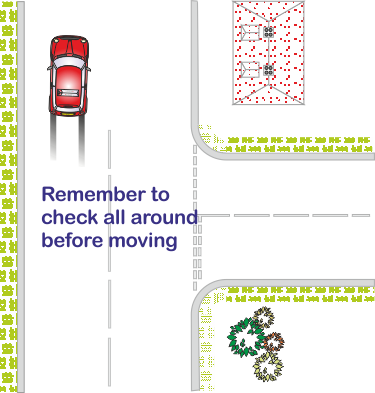 Because you have not parked neatly at the side of the road, you need to take special care when moving off.
Because you have not parked neatly at the side of the road, you need to take special care when moving off.
Ensure the road is clear all around; a cyclist, or even a car, could pass to your left and be hidden in a blind spot.
You might have to move the car very quickly to avoid further danger after you stop, for example, on a fast-moving motorway. You still need to make all of your safety checks; otherwise, you risk creating more risk/danger.
After a real emergency, you might need to find somewhere to park safely and have a short break to recover from the shock, help others, wait for the police or exchange details with another road user.
Click here to complete the quiz for this lesson
 (The page will open in a new window/tab)
(The page will open in a new window/tab)
You will find references for the answers in this lesson or The Highway Code.
You can check your answers as you go along or complete the entire quiz before checking.Leaving the check to the end is an excellent way to test yourself.
When you check or review your answers we give you a brief explanation of the answer.
Good Luck!